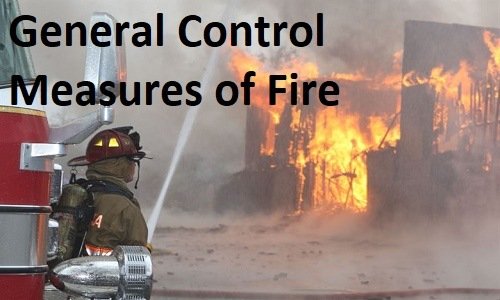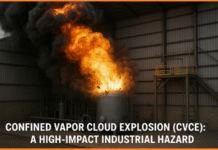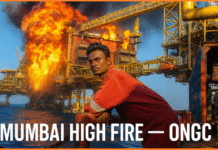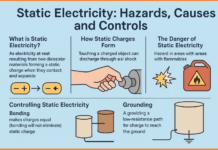A broad classification of fire safety system is explained below:
Fire Safety
- Existence of fire hazard and awakening of fire consciousness of the management
Fire Prevention
- Detection by Detectors (alarms)
- Elimination of hazard or source of ignition
- Control over combustibles in storage, handling and process
Fire Protection
- Fire resistant design of buildings, equipment, means of escape and fixed installations
- Suppression, Extinguishment or control by various extinguishers
Fire Fighting
- Equipment and hardware
- Staff, training and readiness
Fire prevention: This is an activity directed towards elimination of possible and potential sources of fires. It mainly indicates measures to avoid inception of fires. Where the source cannot be eliminated or avoided, exercise sufficient control to ensure its safe usage. The activity also involves control over handling storage and process of combustible.
Fire protection: This is an activity directed towards limiting the spread of fire to its place of origin by resorting to design compartmentation utilisation of fire resistive materials provisions of safe means of escape, control by portable and fixed automatic extinguishing systems.
Fire protection being winder term included fire prevention stated above and fire fighting mentioned below. Fire detection, prevention, extinguishment or control all aim to protect plant, people and property.
Fire protection engineering is a highly developed specialised branch of engineering and a degree of B.E. (Fire) is awarded in collage at Nagpur. Such qualified fire engineer and if he is not available, qualified safety officer should look after fire protection activities.
Fire Fighting: This is an activity directed towards provisions of proper fire fighting equipment, proper maintenance, personnel with proper organisation, training programme and readiness to fight fire.
Salvage: This is an activity to minimise the damage due to fire, smoke and water to the uninvolved property.
Return to normalcy: This is contingency plan where the various steps are laid down to bring back the industry to productive stage from the crippling damage due to the fire.
General Control Measure of FIRE
Main steps in controlling fire are
- To detect the fire at the earliest possible.
- To confine the fire, and
- To extinguish the fire at the earliest possible.
Six fundamental principles of fire prevention and reduction are:
- Fire prevention engineering.
- Regular periodic inspection.
- Prevent the start of fire.
- Early detection and extinguishment.
- Limiting the spread and damage due to fire and control.
- Prevention of personal injuries from fire or panic, including prompt and orderly evacuation of personnel.
Based on fire chemistry four fundamental methods of fire control are:
- Eliminate the oxygen of the air.
- Remove or shut of the fuel supply.
- Reduce the temperature below the kindling point and
- Break the chain reaction continuing the fire.
To achieve the most efficient fire protection system, involvement of the building designer (architect) and contractor, local authority (urban planner), interior designer, structural engineer, electrical engineer, fire detection system, manufacture/supplier, building safety engineer and local fire marshal is necessary.
An automatic sprinkler system becomes most useful as it starts initially. Early detection of fire speedy response , trained staff, emergency planning and preparedness and fixed extinguishment system based appropriately on fire load are the essential key points in any fire fighting arrangement.
To stop the occurrence, following fire prevention activities are desired:
- Fire Inspections: Fire prone area, equipment and conditions should be inspected, periodically may be daily, weekly, monthly etc depending on requirement. A check list should be designed best fitting to the premises and activities. It should include checking of poor housekeeping, accumulation of dust or flammable material, readiness of fire hydrants, hoses, sprinklers, alarm, detectors, water storage, pump/engines, charged portable fire extinguishers, foam, carbon dioxide, DCP and other protection systems, fire doors, aisles, exits, control room, electrical equipment, hot processes and machinery, and placement of fire fighting and personal protective equipment, tools etc.
- Hot-work permits: Many fires have taken place while doing hot-work in flammable areas. A hot work permit from and tag should be designed and use to check all points in advance and to take necessary precautions. Following steps are useful:
- Check the area where work is to be done.
- List steps, equipment and procedure necessary and prepare the permit.
- While at work, constant watch (supervision) is necessary if hazard exists.
- Standby workers should be ready on the spot with fire extinguisher.
- Isolate flammable materials (stop its flow if possible) from sources of ignition.
- Isolate sources of ignition by all possible ways.
- Stop unauthorised use of spark producing equipment nearby.
- Fire brigade and Drills: A plant fire brigade of qualified and trained personnel is necessary to fight fire till outside public fire brigade arrives and helps.
Regular scheduled training of all members of the unit should be carried out. On-site emergency plan involving other employees should be prepared and rehearsed.
- Fire-retardant treatment: Such coatings can be applied on wood, plastic, paper etc. to withstand flame. Fire rating of such substances should be studied for comparison to the non-treated material. Chemical treatment to fabrics reduces their flammability. Flame retardant canvas can be used up to 250 degree centigrade For higher temperature, chrome leather is preferred. Water gel compound can be used to soak a cloth-piece to make it fire-retardant. It should be noted that all such treatments are temporary and not foolproof.
- Communication: After noticing a fire, fast communication is necessary to call for fire fighting team and to alert occupants to the emergency. Well arranged bells, fire call buttons or a coded computerised fire alarm system are essential. Equally important is the training of persons to react after hearing the alarm.
- Protective nearby building: After noticing a fire, it is also necessary to protect the adjacent plant and building by closing windows, positioning personnel at each window nearest the fire, with fire extinguisher or fire hoses and stationing fire fighters on the roof of the exposed building with hose lines to keep the roof wetted and to put off any local fire.
- Assessment of Fire Risks: For effective fire protection, it is necessary to analyse and evaluate the fire risk. Such process aim at-
- Recognition of hazards and potential hazards.
- Evaluation of hazards and expected losses.
- Evaluation of the proposed counter measures.
A fire risk survey should be carried out to list fire hazards. Site, building construction, plant contents, management factors, people factors, fire protection system and post fire activities are the areas to be covered. Highly flammable material and process, smoke and toxic gas generation, people likely to be affected, fire load calculation and specific nature of industry are relevant points.






I LIKE IT
THANK YOU
Clearly described.